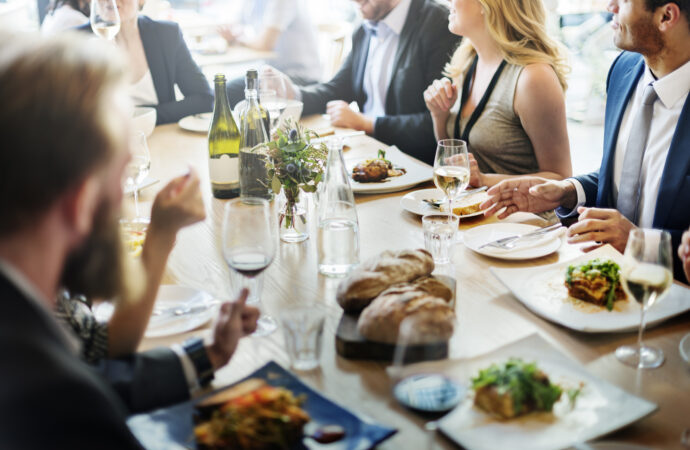Table manners are the rules of etiquette used while eating, which may also include the use of utensils. Napkin Etiquette Place the napkin in your lap as soon as you sit down at a casual meal. Wait for the hostess to remove her napkin from the table and unfold it in her lap before unfolding
Table manners are the rules of etiquette used while eating, which may also include the use of utensils.
Napkin Etiquette

Place the napkin in your lap as soon as you sit down at a casual meal. Wait for the hostess to remove her napkin from the table and unfold it in her lap before unfolding the napkin on formal occasions.
1. When you sit, place the napkin in your lap.
2. When you leave the table, place the napkin on your chair.
3. Fold your napkin and place it to the left of your place setting at the end of the meal.
Handling Utensils
How do you hold a fork?
The continental style prevails at all meals, formal and informal because it is a natural, non-disruptive way to eat.

- Hold your fork in your left hand, tines downward.
- Hold your knife in your right hand, an inch or two above the plate.
- Extend your index finger along the top of the blade.
- Use your fork to spear and lift food to your mouth.
When to Start Eating

Wait until everyone else has been served before beginning to eat at a small table of two to four people. At a formal or business meal, you should either wait until everyone has been served or start when the host requests it.
Resting Utensils

When you take a break or finish eating, how do you leave your knife and fork on your plate?
When you take a break to take a sip of your beverage or speak with someone, rest your utensils in one of the two styles listed below:
Continental Style: Place your knife and fork near the center of your plate, slightly angled in an inverted V, with the tips of the knife and fork pointing toward each other.
American Style: Place your knife on the top right corner of your plate (diagonally), next to your fork (tines up).
When each course is completed:
Place the knife and fork in the four o’clock position on the right rim of the plate, parallel with the handles.
Passing Food Etiquette

Pass to the right (if the item is not being passed to a specific person). One diner either holds the dish as the next diner takes some food, or he hands it to the person, who then serves herself. Any heavy or awkward dishes are put on the table with each pass.
Bread Passing Etiquette
- If the loaf is not cut, cut a few pieces, offer them to the person to your left, and then pass the basket to your right.
- Do not touch the loaf with your fingers, instead use the clothe in the breadbasket as a buffer to steady the bread as you slice it.
- Place the bread and butter on your butter plate – yours is on your left – then break off a bite-sized piece of bread, put a little butter on it, and eat it.
Salt and Pepper Etiquette
Always pass the salt and pepper together.
Soup Etiquette

How do you eat soup?
Hold the soupspoon by resting the end of the handle on your middle finger, with your thumb on top. Dip the spoon sideways at the near edge of the bowl, then skim away from you. Sip from the side of the spoon. To retrieve the last spoonful of soup, slightly tip the bowl away from you.
Seating Etiquette

You should allow your host to direct you to your seat if he has seating arrangements in mind. As the host, you should make suggestions for seating.
In a restaurant, the honoree should take the best seat at the table. Typically, this is one with the back of the chair against the wall. Once the seat for the guest of honor has been determined, the host should sit to her left. Other people are then invited to take their places at the table.
Food Service Etiquette

During formal dinner service, the food is brought to each diner at the table; the server places the platter or bowl on the diner’s left. At a more casual meal, the host either dishes the food onto guests’ plates for them to pass around the table, or the diners help themselves and pass it to others as needed.
Meals End
At a formal affair, plates are removed by a professional staff. But as most informal meals are served without help, the hostess clears the plates, often with the help of a guest or two. At a family meal, members clear their own plates.
Clearing the Plates
- If the meal is formal, plates will be removed by the staff.
- At informal meals, the hostess will probably clear the plates, possibly with one or two guests helping.
- At a family meal, members clear their own plates.
Leaving the dining room. To signal dinner is concluded, the hostess catches the eye of the host, lays her napkin on the table, and suggests that everyone go into another room for coffee and after-dinner drinks. The hostess rises from her chair.
When it’s time to leave, rather than detain one’s host with a lengthy goodbye, make the departure brief but cordial.
 Magazine
Magazine 


















Leave a Comment
Your email address will not be published. Required fields are marked with *